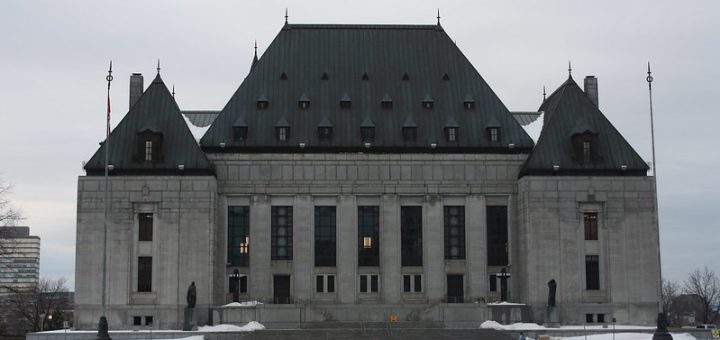Slipping, Sliding, and Snow Removal Woes: The Extension of Tort Liability to Municipalities

Winter is often stressful as many residents attempt to clear the sidewalk in front of their house or business to avoid being sued for an unsuspecting slip or fall. In 2021, the Supreme Court of Canada (“SCC”) settled an ambiguous area of law by extending tort liability to municipalities for improper snow removal. The SCC unanimously ruled in Nelson (City) v Marchi, 2021 SCC 41 [Nelson] that municipalities should not be granted immunity if facing allegations of negligent snow removal.
The Facts
Taryn Joy Marchi, the respondent in Nelson, sued the City of Nelson for negligence for an injury she sustained while walking over a snowbank. Between January 4th and 5th of 2015, the City of Nelson, British Columbia experienced a heavy snowfall and Nelson city employees plowed the snow and sanded the streets and sidewalks in response. This included clearing the snow in angled parking stalls on Baker Street, located in the city’s downtown core where Ms. Marchi later parked her car. According to the “Streets and Sidewalks Snow Clearing Removal Policy,” Nelson’s official snow removal policy, snow removal is carried out on a “priority schedule that best serve(s) the public and accommodates emergency equipment within budget guidelines” (Nelson, para 8). The City of Nelson also abides by several unwritten practices, one being that Baker Street and the accompanying sidewalk be treated as an area of focus for snow removal by city employees. While clearing the parking stalls on Baker Street, city employees inadvertently piled the snow into a snowbank that blocked access to the sidewalk for individuals that parked in the stalls.
The day after the heavy snowfall and the city employees’ subsequent snow removal, Ms. Marchi parked in one of the stalls and attempted to cross over the aforementioned snowbank to access the sidewalk. As she stepped over the snowbank, she fell into an area that seriously injured her foot. In response to this incident, Ms. Marchi sued the City of Nelson for $1 million in damages.
The Law
Before delving into the ruling, it is essential to provide a quick synopsis of the law involved in the decision. In order to be liable for negligence, a party must owe another a duty of care. Donoghue v Stevenson set forth the neighbour principle, which is the idea that a duty of care is owed “to those whom they ought reasonably to have in contemplation as being at risk when they act” (Nelson, para 15). Determining who is a “neighbour” is contemplated through the Anns/Cooper framework, which examines (1) whether a prima facie duty of care exists and (2) if “the harm was a reasonably foreseeable consequence of the defendant’s conduct” as well as if “there is a relationship of proximity” (Nelson, para 17). Finally, the Anns/Cooper framework examines any policy concerns outside of the case that may negate the duty of care (Nelson, para 17). The SCC used the established precedent in Just v British Columbia, where it was determined that the government owed a duty of care to residents when a boulder fell from a highway onto an individual’s vehicle (Nelson, para 20).
Finding that a municipality owes a duty of care does not automatically create liabilities. It must first be determined whether the policy decision that created a duty of care was “core” (non-liable) or “operational” (liable). Core policy decisions involve decisions taken “‘at the highest level’ of government to adopt a course of action based on health policy or other ‘social and economic consideration’” (Nelson, para 39). Operational decisions involve “‘the practical implementation of formulation policies’ or ‘the performance or carrying out of a policy’” (Nelson para 52).
Procedural History
Supreme Court of British Columbia
The trial judge, Justice McEwan, found that the City of Nelson did not owe Ms. Marchi a duty of care because the decision to remove the snow was a core policy decision. Thus, the city was not liable for her tort claim. Justice McEwan found that the snow removal was a core policy decision, in part, because the decision to remove snow involved taking into consideration budgetary implications. Moreover, relying on testimony from a City of Nelson supervisor, the decision-making process made by employees involved deferring to higher-ups. Justice McEwan also found that even if the City of Nelson owed of duty of care to Ms. Marchi, they would not have breached the standard of care owed because the snowbank was not an unreasonable risk of harm. To add insult to injury, it was concluded that the respondent was the “author of her own misfortune” (Nelson, para 11).
Court of Appeal for British Columbia
The British Columbia Court of Appeal (“BCCA”) disagreed with the findings of the trial judge and unanimously ordered a new trial. The BCCA found that the City of Nelson owed Ms. Machi a duty of care. They found that the trial judge’s decision was “coloured” by the determination that snow clearance was a core policy decision that provided immunity (Nelson, para 12). It is important to note that the BCCA did not settle whether a duty of care was owed, leaving that to be decided at the new trial. In addition to this, the BCCA found the trial judge’s assertion that Ms. Marchi’s injury could have been avoided and that she was the cause of her own misfortune to be improper.
Issues on Appeal
There were three issues on appeal:
(1) Did the trial judge err in concluding Ms. Marchi was not owed a duty of care?
(2) Did the trial judge err in his standard of care analysis?
(3) Was the test for causation adequately applied?
Application of the Law – The Trial Judges Errors
In a unanimous decision, the SCC notes that the trial judge took an expansive view of the City of Nelson’s snow removal policy and thereby failed to apply the appropriate laws and analysis (Nelson, para 76). First, the trial judge’s analysis examined the snow removal process as a whole rather than focusing on the clearing of snow from the parking stalls on Baker Street, which ultimately created a hazard for Ms. Marchi. The trial judge’s decision should have focused on whether the city was negligent in how they plowed the parking spaces and where they created and placed the snowbank. Second, the trial judge accepted the formal snow plowing policy without considering the unwritten practices (Nelson, para 77). The SCC found that the trial judge improperly examined the formal policy and unwritten practices as two distinct concepts rather than one snow removal framework. Focusing on only the formal written policy was a simplistic understanding of the word ‘policy’ and should not have alone guided the trial judge’s decision. Third, the SCC determined that the snow removal was not, in fact, a core policy decision. Specifically, budgetary implications, used by the trial judge to justify their reasoning, do not alone make a core policy decision. The SCC notes that even the most routine decisions involve some considerations of budgets or the scarcity of resources (Nelson, para 77). The SCC further determined that the decision to plow was not a core policy decision because it was not deliberated, rather it was one based on custom (Nelson, paras 82-83). The Court stated that “core policy decisions will often be formulated after debate – sometimes in a public forum – [with] input from different levels of authority” (Nelson, para 55). In this instance, the trial judge placed undue weight on the testimony of a City of Nelson supervisor who claimed that she was following directives directly from above. By placing low value on the supervisor’s testimony, the SCC found the decision to plow to be more aligned with an operational decision. Finally, the method in which parking stalls were assessed when determining whether to remove the snow is based on objective criteria, and is not complex, also suggesting that this was an operational decision (Nelson, para 84). There is no need to examine previous case law to determine liability because it is “not different in kind or complexity from those which courts are accustomed to entertain[ing]” (Nelson, para 84). A reasonable standard of behaviour can be expected when removing snow, which can then be used to determine whether there was a negligent act. Thus, the decision to remove snow is an operational decision and enables a municipality to be held liable for its actions.
The SCC found that the City of Nelson owed Ms. Marchi a duty of care and rejected the trial judge’s finding that a standard of care was not breached. Moreover, the SCC found that the lower court allowed a finding of “core policy decision” to improperly influence the rest of the analysis (Nelson para, 90). The trial judge should have applied the test to determine if the City of Nelson breached the standard of care – whether a defendant must “exercise the standard of care expected that would be of an ordinary, reasonable, and prudent person in the same circumstances” (Nelson, para 91).
The trial judge’s decision on causation was also quickly disposed of as the SCC held that finding the respondent was the “author of her misfortune” was wholly inadequate (Nelson, para 94). The trial judge could have, instead, applied the ‘but for’ framework on a balance of probabilities (Nelson, para 96). This asks, ‘but for’ the City of Nelson’s removal of snow, would Ms Marchi have been injured? Additionally, the trial judge should have considered if the harm was ‘too far remote,’ by asking if the injury was reasonably foreseeable (Nelson, para 97). Unfortunately, the trial judge failed to apply either test and, as a result, erred in the analysis. Similar to the BCCA, the SCC left the determination of the appropriate standard of care and the issue of causation to be assessed in a new trial.
Conclusion
In conclusion, the SCC in Nelson found that the City of Nelson owed a duty of care and its decision to remove snow was not a core policy decision, thereby opening Nelson and other municipalities to liability. The SCC dismissed the City of Nelson’s appeal, and the questions on standard of care and causation required a new trial. The Nelson decision seems to have altered tort law as “accountability for [harm] is found in the ballot box, not the courts” for municipalities (Nelson, para 1). It is now clear that the courts will be a mechanism of accountability, ensuring that municipalities meet a reasonable standard of care. This decision opens a new way to hold municipalities responsible for their negligent actions but begs the question of whether the floodgates have been opened for lawsuits that target municipalities. The only thing that municipalities know is that they must brace themselves as ‘winter is coming.’







Join the conversation